Introduction and Flight on AA
Google Maps in China
Sheraton Changzhou Xinbei Review
Changzhou Summary
Intro to China High Speed Rail System HSR
Cantonese Food and Ramen in Shanghai
Intercontinental Shanghai Puxi Review
Nanjing (City Wall, Nanjing Massacre Memorial, Purple Mountain)
Suzhou (Tiger Hill, Humble Administrator’s Garden)
Changzhou Tianning Temple
Hangzhou (West Lake, Leifeng Pagoda, Longjing tea)
Flight Home and After Thoughts
During the first trip here, I have used this system for about three weeks traveling mainly between Shanghai and Changzhou, but have also went to Suzhou and Nanjing on both sets of tracks. One quick tip is to get to the station early. Whatever time is on your ticket, often times the train will leave a few minutes (2-4 minutes) before stated on the ticket so ensure you are there at least 10 minutes before. Also, the schedule is online at chinatrainguide.com, which is very useful and handy for foreign tourists.
In Shanghai there are two main HSR stations, Shanghai Railway Station near Shanghai Railway Metro Station on Line 1 and Shanghai HongQiao Station on Line 2. If you are staying in Shanghai proper, then Shanghai Railway Station is the closest to the city. Shanghai HongQiao takes about 40 minutes on Line 2 while Shanghai Railway is closer to about 20 minutes. In terms of crowds, both seem to be equally busy. There are some trains to only depart from HongQiao and a few only from Shanghai Railway so make sure which one you will need.
To purchase a train ticket, you will need a China local ID or a passport. If you think you can speak some Mandarin, you can just walk up to the counter, say which train or destination you want and then buy the ticket. You can also write down which train you want and show them the paper. There could be a chance you picked a train that is either going to leave very soon or you are at the wrong station (see below about multiple train stations). There are automated vending machines, but they are for Chinese residents with ID only.

China CSR Train Ticket
The easiest way for foreigners to get a train ticket is to book one through the concierge of the hotel. They have a travel agency that can book the ticket for a nominal fee (5 or 10CNY). This beats waiting on line at the station for an hour or more to get a ticket. Another option is to find a travel agency to buy the tickets from. I did not take this path as I wasn’t sure if these places were real or not, and did it through the hotel. The best time to get it at the train station is late at night as there are very few trains that run overnight. HSR tickets can be bought a few days ahead so you can stop by the night before or a few days before to get a ticket. It’s best to plan ahead of time and get a bunch of tickets. Don’t worry about delays or cancellations as you can get a refund from any station and in cash. You can also change the ticket to another train but this involves a long line as well and some broken Mandarin. It’s definitely not a huge deal to get tickets at the station, but I just hate waiting on lines. During the day, the normal wait is about an hour and can be up to two hours unless it is a holiday.
Be careful of Chinese Holidays as it may limit the availability of train tickets. The train system is widely used for people to get back to their home town, especially during Chinese New Year. I was only traveling between Changzhou and Shanghai the days before Chinese New Year and i didn’t have trouble getting tickets as there are so many trains on this line. Like in the US, many people leave major cities on the weekends, mainly Friday night. When i was arriving in Shanghai the Friday before Chinese New Year in 2013, there was a long line before security to get into the station as I was walking to the mtro. i would guess most of these people were taking the local or overnight trains back home but if you had to catch a train in 30 minutes, well you wouldn’t make it. I have never seen the line this long before and it should be only this long for holidays. The line through security on Monday morning out of Shanghai Railway was not an issue, even considering it was a few days before Chinese New Year.
There are two sets of high speed tracks between Shanghai and Nanjing. The first set goes through all of the original railway stations, starting in Shanghai Railway station in Puxi (on the red line metro system) and goes towards Nanjing. These trains usually take a bit longer since many trains stop at more stations and also have the slower and cheaper D series train (250km/h) versus the G series fastest and more expensive train, capped at 300km/h.
The other set of tracks is brand new and many of trains go to Beijing. This set of tracks originate in HongQiao station west of the city and many of the stations between Shanghai and Nanjing are completely new and are usually on the other side of each city it stops in relative to the “original” stations. Usually the original stations are called Changhzou station, for example, while the new stations are called Changzhou North. You will need to be very careful which stations you are going to and from since it can be a bit far from where you actually need to be. This is especially true since HongQiao and Shanghai railway stations are very far apart (about 45 minutes by local metro with a transfer in between). Sometimes for trains at a certain time or duration, they will only go to Shanghai Railway or HongQiao station. This is especially true on the newer set of tracks since it will almost always go to HongQiao station.
The new set of tracks have more advanced tracks and structures that can allow trains to travel up to 350kmh. An example of that are dedicated bridges over highways and rivers whereas the original tracks would have a long span concrete arch bridge.
Often times, traveling on the G trains on the newest Beijing-Shanghai line will be faster since they will be stopping at less stops, even though the maximum speed on both lines on the G series trains is 300km/hr. The way the train stops are set up is that many trains will stop at major stations (Shanghai, Nanjing) and then different trains, about 10 minutes apart, will stop at the smaller stations in between. Depending on the station, there will be a train to Shanghai or Nanjing every 10, 20, 30 or sometimes 40 minutes, depending on the size of the station. This is a very neat way to maximizing the number of passengers while having many trains running on the line. From what I read online and my experience, each train on the same track is roughly 10 minutes apart.
There are three classes of train tickets: Second class, First Class, and Business Class. The business class is the highest class available, which i thought it was a bit weird since airlines have it the other way around. Second class sits 5 person across each row, First class is 4 a row, and Business class is 3 per row with lie flat seats like the airlines. CNN did a review of the trip on the maiden voyage to Beijing: http://travel.cnn.com/shanghai/visit/beat-bullet-108-minutes-shanghai-beijing-high-speed-train-088060
For tourists, its best to go with First Class since it is usually a bit quieter with less people and worth the extra cost. First class has more legroom so its easier to stow large luggage in front of your legs. Sometimes the noise is unavoidable even in First class so for short hops you can try to get a Business Class seat for not much more money. In Chinatrainguide.com, look up fares for D or G series trains (D7803, or G10, for example). They will have the second class and first class fares listed. Expect Business class to be about 50-80% more than first class. For short trips, it might be the difference between 12 or 20 bucks, which is not bad. Farther trips between Shanghai and Hangzhou might go up from 30US to 50US. Also, all the seats are facing forward. Each seat can rotate so at the end of each trip, they will reverse the seats for the outbound trip, which is pretty neat. Labor intensive, but neat.
Each train has both sets of toilets: squat toilet and a regular sit down toilet. In the same area they have dispensers that serve hot water. I have never seen the cafe train car, but if you are in First/Business class, they come around with a small bottle of water and a small snack. Also, small bottles of water are usually given out at the train station to people on the high speed trains.
As many have probably reported, the train stations are set up like airports. The departure areas are usually on the 2nd floor, while the arrival area is in the basement, assuming the tracks are on ground level. Often times, the tracks are elevated. There are usually metal detectors that guard the top level.
There will be many displays all over the train station that will say what time the train is expected to arrive and which gate you should be at. It should be pretty intuitive to see where train G10 will be boarding at what time, even if you do not know how to read Chinese. The key will be remembering your train number and what time it should arrive.
Each train station has a set of turnstiles or gates that are activated by your train ticket. You will need to be in the waiting area until 10 minutes before the time on your ticket. Then the gates will allow your ticket to enter. There is usually a change in the electronic signs that says they are boarding now. I believe the font that has your train number will turn green.
Put in your ticket and it will be returned to you and the gates will open. Make sure not to step inside the turnstile area since it will not open if you are within it (just right behind the gate doors). I’ve seen a few locals confused as to why the doors are not opening.
The ticket will have a car number and seat number. Sometimes, your car number might be incorrect since they might be running less cars, hence there is no longer train car #15 anymore. They will usually have workers stand with signs as to where to stand for car number 10 or 12, for example.
Otherwise, if you do not see people with signs, there are numbers on the station floor that says what car number will stop where. When the train pulls up, the train number and car number will be on the digital display at the ends of the car so you should be able to find it quickly. If not, just get on and walk through the entire train until you get to your car. The women attendants should be able to speak English and should be able to tell you which direction to walk to. Also, make sure you are getting on the correct train by checking the train number on the display. Sometimes there’s a train going in the same direction but a different train number. This is rare as the minimum space between trains is about 10 minutes and usually in 5 minutes, the train stop and leave. However, if you start at a major station like Nanjing, HongQiao or Shanghai Railway, there may be two trains leaving about 5 minutes apart that are on the same set of platforms.
Each ticket has your seat number so you won’t have to rush down to the train to get the best seat. There is a slight problem with reserved seats as a few people mentioned in discussion with online ticketing for Amtrak Acela trains. Say there is an open seat between station A to B, B to C, and C to D. However, those open seats are not the same. When I go and purchase a ticket from A to D, the computer will tell me there is no available ticket, even though I know there must be an open seat from A to D. I have only been denied getting a ticket only once but i suspect that this was the case. Because of the pre-assigned seats, I highly doubt each and every seat was taken up for it to be sold out. However, if the train is only running between two large cities, this can be very possible as there is a chance very few people are getting off in the stations in between.
To get out of the station at your destination, you will still need your ticket to get out the same way you got in. Sometimes if its very crowded you can just walk through with the person in front of you.
Overall the trains are very smooth and clean. The normal sit down style toilets on the train are pretty clean as well since no one would use it. One downside is that at times, there could be some rowdy people on the train, but it can be avoided if you can afford First or Business Class seats.
You can also buy a China HSR model train set (2588CNY):
Changzhou North Station:
Nanjing South Railway Station:
Suzhou Station:




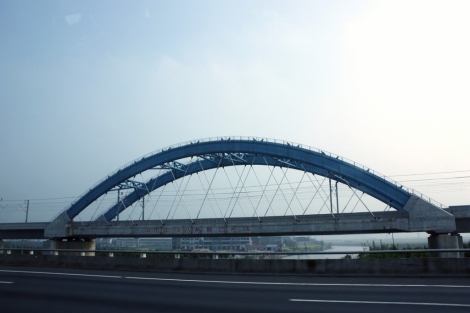


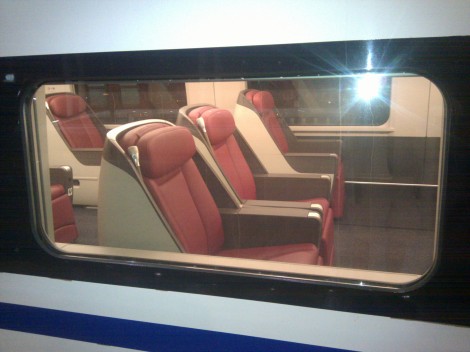


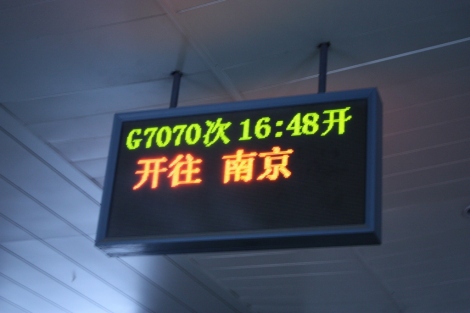
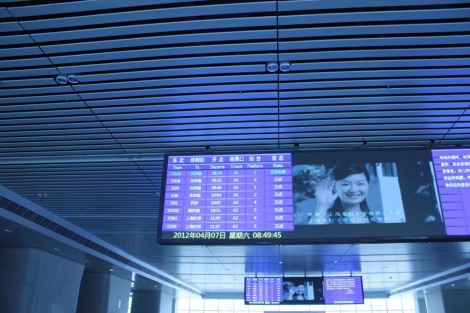






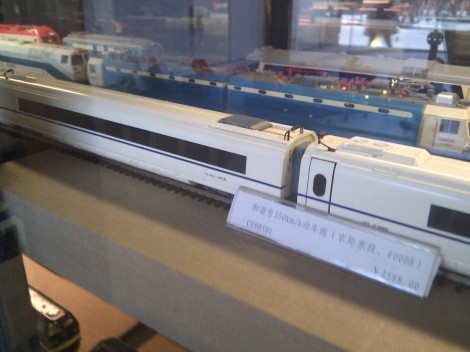







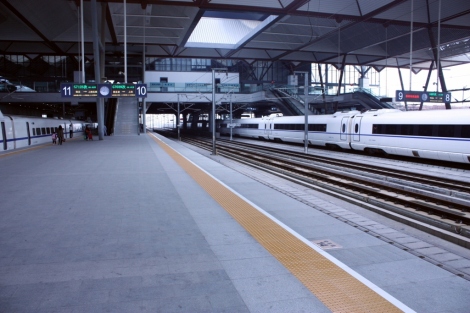



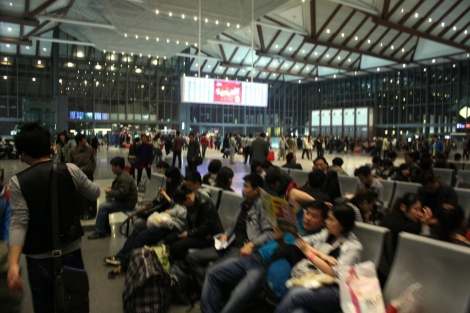



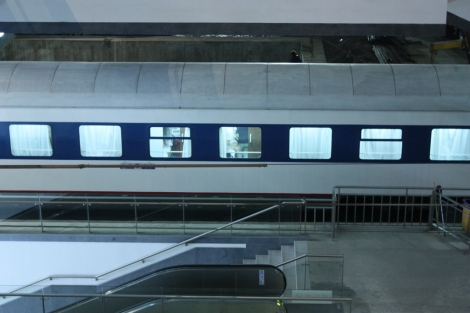





Be the first to comment on "Shanghai 2012: Intro to China High Speed Rail System HSR"